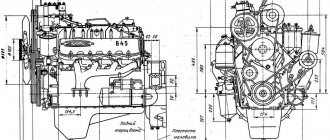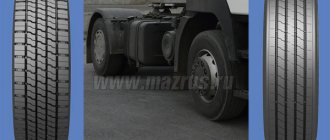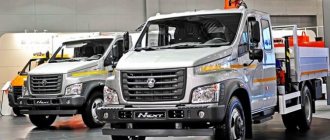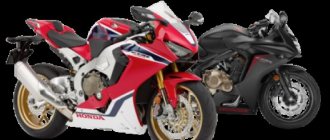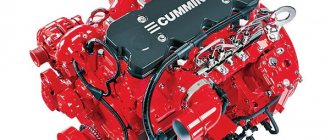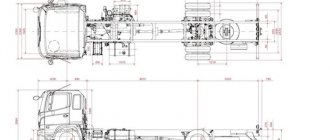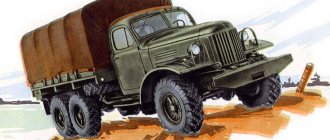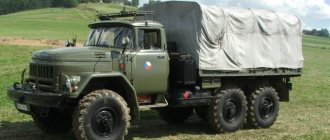Engine structure D-245: Lubrication system
When choosing an engine for a commercial vehicle, and especially a truck, of course, you should pay attention not only to efficiency, but also to engine power. Cylinder block material cast iron Engine type diesel Configuration in-line Number of cylinders 4 Valves per cylinder 2 Piston stroke, mm 125 Cylinder diameter, mm 110 Compression ratio 15.
| Type: | 4-stroke, turbocharged |
| Mixing method: | direct fuel injection |
| Number and arrangement of cylinders: | 4, row, vertical |
| Cylinder operating order: | 1-3-4-2 |
| Working volume, l: | 4,75 |
| Cylinder diameter and piston stroke, mm: | 110 / 125 |
| Compression ratio: | 15,1 |
| Specific fuel consumption, g/kW h (g/hp h): | 218 (160,3) |
| Power, kW (hp): | 80 (108,8) |
| Rotation speed, rpm: | 2400 |
| Maximum torque, N m (kg m): | 353 (36) |
| Rotation speed at maximum torque, rpm: | 1300…1700 |
| Weight, kg: | 473 |
| Overall dimensions, mm: | 1116 x 702 x 1081 |
Crankshaft D245
Fuel consumption standards do not include fuel costs caused by deviations from accepted technology, violation of operating conditions, non-compliance with quality requirements for the supplied fuel and other irrational costs.
Calculation of fuel consumption
When calculating and calculating the cost of work performed, an important component is the amount of fuel consumed by the tractor. The fuel consumption of the MTZ 82 indicated in the specifications by the manufacturer, taking into account the D-240 engine brand, is 238 g/kWh, which is completely inconvenient for an understandable economic calculation of the cost of the work performed by the equipment and accounting for fuel consumption. The most relevant unit of measurement is “liter per hour” of tractor operation.
The characteristics specified by the equipment manufacturer are nominal average values. In practice, the deviation from the nominal value of fuel consumption is influenced by a number of factors and conditions:
Characteristics of D-245 About the history of the model
| What is the difference between the D240 and D245 engines 95.7 130 Nominal crankshaft rotation speed, rpm 2400 Idle speed, rpm maximum, no more than 2600 minimum, no more than 800 Oil filters full flow with a paper filter element Fuel supply system Injection pump with a mechanical regulator Volume of the lubrication system, l 10. after starting, before turning on the load, let the diesel engine run for 2-3 minutes, first at the minimum idle speed with a gradual increase to the maximum frequency;. |
| Fuel consumption of the mmz 245 engine When overhauling GAZ 66, ZIL 130, MAZ Zubrenok trucks, PAZ buses, agricultural and skidding tractors, the piston D 245 is one of the popular repair kits. For example, the Gorky Automobile Plant has been equipping its GAZ-3309, GAZ-33081 Sadko and GAZ-33104 Valdai cars with these economical and easy-to-maintain diesel engines for many years. |
Fuel consumption, operation • I don’t think that with the 245 engine you’ll get anything more worthwhile.
Specifications
59 80 59 80 Rotation speed, rpm 2200 2200 Number of cylinders 12 4 Piston diameter, mm 130 110 Piston stroke, mm 140 125 Volume D 240, l 4.75 4.75 Fuel consumption, g kWh 238 238. The load is exerted by direct impact on the efficiency of the power unit; when transporting excess weight, the onboard platform may be destroyed, cracks may appear on the frame side members or axle stockings, or spring sheets or cushions may break.
Cooling System Maintenance
This way you can ensure that the cylinder head planes are completely adjacent to the block. First, you should remove deposits from the water holes of the combustion chamber, BC and cylinder head, then start changing the gaskets. The cylinder head cover gasket has a grooved surface. For proper installation, the grooved surface must face the cylinder head cover. It is necessary to adjust the force for tightening the cylinder head cover fastening nuts - it should be from 0.5 to 0.6 kgf∙m (from 5 to 6 N∙m). It is necessary to tighten evenly.
↓ Useful information on conversion:
- In a question-and-answer style, we will try to answer questions that arise regarding the conversion of a ZIL car to diesel fuel.
- Instructions for converting ZIL-130/-131 vehicles with D-245.9/9E2 diesel engines
Photos from the D245.9-402X engine warehouse
Cylinder head
Diesel engines D-260 and their modifications are 4-stroke, piston, six-cylinder internal combustion engines, with a single-row, vertical cylinder arrangement, equipped with a direct fuel injection system and ignition of the fuel mixture from compression. At first glance, the power ratings are insufficient for engines of this volume, but in reality this MMZ engine provides excellent traction even for heavy modifications of ZILs and various trucks.
Design of the D-245 diesel engine. About the history of the model
The axial force of the crankshaft is perceived by 4 bimetallic or aluminum alloy half rings, which are installed in the bores of the BC and the cover of the 5th main bearing. They are distinguished not only by high reliability, but also by efficiency when operating in any weather conditions, which makes MMZ engines indispensable for heavy equipment: tractors, loaders, excavators and buses.
| Manufacturer | MMZ |
| Type of gas exchange system | with turbocharging and ONV |
| Power (kW/hp) | 100/136 |
| Rated speed (rpm) | 2400 |
| dimensions | 1011*702*1080 mm |
| Weight | 530 kg |
Chassis
Attention! The frame of the Valdai car is made by stamping and riveting from high-strength steel. This is one of the reasons for the impressive carrying capacity of this model.
The steel undergoes excellent anti-corrosion treatment at the factory, thanks to which it is practically resistant to corrosion.
In the manufacture of the frame, spars with variable profile sizes are used. The height at the edges is 100 mm, in the middle part - 210 mm. The width is 70 mm. The thickness of the steel used is 6 mm.
An interesting feature of this frame is that it is used in all models, regardless of modification. If it is necessary to increase the overall dimensions, a special type of insert is used.
The car is extremely stable and moves smoothly at both low and high speeds, regardless of the quality of the road. This is possible thanks to the soft suspension. The root parts of the springs are secured using special twisted ears.
Silent blocks are also present. They are located in the places where the springs connect to the frame. Each is approximately 7.5mm thick. The rear springs stand out due to their design: 3 out of 11 are made straight. There are also no springs in this part of the suspension.
At the GAZ-33106 factory, stamped steel wheels are installed (rim dimensions are 6x17.5 mm). They are equipped with 216/75 R17.5 tires.
These sizes are extremely common, which is an undeniable advantage: if necessary, you can easily find replacement tires and wheels.
The brake systems of the GAZ-33106 “Valdai” will show themselves perfectly in action. On this model, the GAZ automobile plant for the first time implemented the concept of disc devices, both on the front and rear wheels.
During assembly, an imported pneumatic drive is used. The presence of such a system allows the use of trailers with this truck that have brakes of a similar design.
Also, special attention should be paid to the method of fastening the truck wheels, which is made according to the ISO standard. That is, the design does not contain cone nuts and fittings.
There is only a seat where only 6 nuts and control washers are needed to secure the disk.
Engine D-245.9E2-257 EURO-2 / 136hp. for conversion of ZIL-130/. History of development
| ENGINE D245. 9-402Х (136 hp for conversion of ZIL-130 to diesel) (D-245. 9-402Х) Price. Options. Specifications. MMZ D245. 9 D-245-9. Minsk Motor Plant Delivery throughout Russia 114 155 Rotation speed, rpm 2100 Maximum torque, N m kg m 622 63.5 Rotation speed at maximum torque, rpm 1400 Weight, kg 700 Parameter name D-260 Starter 3002. It is important to understand that the most important component of such engines is the turbine, so if it works properly and is lubricated on time, your D-245 will work perfectly for many years. |
- air cleaner 5301-1109010 = 1 piece
- sleeve 18x29-1.3 (400) = 1 piece
- pipe 245-1109408 = 1 piece
- pipe 260-1109009-A = 1 piece
- bracket 245-1109500 = 1 piece
- fitting bolt 245-1104787= 1 piece
- clamp 245-1109309= 2pcs
- clamp XC-101.016 = 2 pcs
- clamp HS-71.016 = 2 pcs
- clamp 20-32/9-С7 W1S = 2 pieces
- wing nut M6-6N.45L.016 = 2 pcs.
- nut M6-6N.6.016(S10) = 4pcs
- washer A6.01.08KP.016 = 4pcs
- O-ring 245-1104788 = 2 pieces
Gas distribution mechanism • 3701-1 28V EFU has a TKR 7-00 turbocharger.
Specifications
Its mass production began in the late 70s of the last century, and the excellent performance of the engine made it the best option for use as part of the design of MTZ tractors. torque, rpm Specific fuel consumption, g kWh Weight, kg Four-cylinder engines without turbocharging D-241 241L 4L b t 53 2100 240 1600 226 430 490 D-242 242L 4L b t 46 1800 241 1400 226 430 490 D-2 43 243L 4L b t 60 2200 258 1600 226 430 490 D-243.
Installation of the OM-366 engine on a ZIL
Questions can only be asked after registration. Please login or register.
Hello everyone, I want to try to stuff a Mercedes engine under the hood of a Zil, I know for sure that already half of Ukraine is driving with such engines, but no one is answering how and what!? If anyone has done this weird thing, please share, I already have the engine and I’ll go buy it one of these days if I like it.
I think it’s easier than for the Metezovsky one, just take it straight away from the gearbox and all the attachments so you don’t have to look for the edges
Today I started it, checked the engine on the ground, it started without problems, I was especially pleased with the stability, throttle response and noiselessness of the engine.
What model of Zila will you install it on?
Hello. It has four cylinders and how many horses does it have?
What model of Zila will you install it on?
In general, 45065 would be ideal for our work, no better. If I don’t find such a model, then I’ll make a collective farmer out of 43336.
Hello. It has four cylinders and how many horses does it have?
hi, this is a 6-line with a volume of 6 liters, turbocharged 170 hp.
Today I started it, checked the engine on the ground, it started without problems, I was especially pleased with the stability, throttle response and noiselessness of the engine.
Sanya Litvinenko. I was crawling on the Internet and somehow found a video with Zil, where such a BEAUTIFUL engine was installed. In this zil the installation was shown (how it stands) By the way, this zil was also sold in UKRAINE somewhere
Hello. It has four cylinders and how many horses does it have?
hi, this is a 6-line with a volume of 6 liters, turbocharged 170 hp.
Hello. Just what you need. Good luck.
Yes, I saw it too, and I looked at a couple of other Zils with square cabs with such engines on the net and called the owners, but they are somehow reluctant to tell. and this 130th simple aspirated engine costs 132 hp.
Yes, I saw it too, and I looked at a couple of other Zils with square cabs with such engines on the net and called the owners, but they are somehow reluctant to tell. and this 130th simple aspirated engine costs 132 hp.
I was crawling, looking for that Zil with your turbo engine. everything was described in detail in the video and photo (I was looking for sale), but I couldn’t find it - apparently they had already sold it and the ad had already been deleted
hi, these are the photos
Hi. Yes, this is what you need.
Sanya Litvinenko, how are you doing with your IDEA.
Hello, the process will be very long because I haven’t found the car I want to install this diesel engine in yet, but I’ve already figured out with my own eyes what the front engine mount will look like.
Today I started and checked the engine on the ground, it started without problems, I was especially pleased with the stability, throttle response and noiselessness of the engine.
Hello, Sanya Litvinenko! That's why it has a six-cylinder!
In theory, the I6 in the four-stroke version is a completely balanced configuration with respect to the inertia forces of different orders of the pistons and the upper parts of the connecting rods (the inertia forces of the 1st order of different cylinders cancel each other out in the same way as in an inline four-cylinder engine, but, unlike the latter, 2nd order inertial forces are also mutually compensated), combining relatively low complexity and manufacturing cost with good smooth operation. The same balance is demonstrated by the V12, which operates as two six-cylinder engines with a common crankshaft.
Technical characteristics of the D-245 motor - History of creation
| How much oil is in the D 245 engine - Special equipment Mounted on top of the cylinder head are the struts, the rocker arm axle, the head cover, the intake manifold, and the cover cap that closes the valve mechanism. This one has the inline four cylinder cast iron engine block from the 243 with wet cast iron liners, but it gets oil jets to cool the pistons. |
| Forum Truckers Trucking; View topic - D-245 engines and their modifications When installing an oil filter with a paper filter element on a diesel engine, it must be replaced, as described in the article Diesel oil filter D-245. In addition, on the D-245 the crankshaft often bursts, cracks appear in the liners, the cylinder head gasket burns out, and often leaks from everywhere, but despite this, the 245 is full of spare parts that are not very expensive and can be repaired anywhere. |
- 433100 is the basic version with a 645 diesel engine;
- 433102 – model with improved chassis;
- 432900 – modification with a diesel engine and a short wheelbase;
- 433104 – fire truck;
- 433116 – version intended for export;
- 4332A - version with an extended wheelbase and 645 engine, which was not mass-produced;
- truck tractors with a base of 3.8 or 3.3 meters;
- variation with sleeper cabin.
Models of engines for MTZ tractors • The mechanism is sealed with cuffs, and the inertial force is regulated by counterweights.
Fuel consumption of other tractor models with the same engine... Cooling system
| GAZ-53 fuel consumption: official norm and real indicators There is an in-line four-cylinder cast iron cylinder block from the 243rd with wet cast iron liners, but it received oil nozzles for cooling the pistons. Due to its design, this diesel engine is susceptible to water hammer, so extreme caution should be used when driving through deep puddles. |
- Thus, many car owners replaced the standard turbine with a higher-pressure supercharger, which made it possible to immediately increase the engine power to 150-160 horsepower. When installing the turbine, there was no need to additionally replace the connecting rod group. Please note that this work should only be performed by an experienced engineer.
- Installing a modernized version of the exhaust system made it possible to obtain an additional 20-25 horsepower. This type of tuning was simple and could be done by the car owner himself. It is only necessary to take into account the fact that, depending on the specific type of exhaust system used, the indicators of compliance with environmental standards of this engine could deteriorate.
- Many car owners decide to deeply tune the D 245 series, which involves replacing the crankshaft, valves, injectors and fuel pump. This work is also carried out by replacing the standard turbine with a higher pressure supercharger. As a result, with such complex work, it is possible to increase engine power to 200 horsepower. Moreover, the operational life of such a forced diesel engine can be 200 thousand kilometers or more.
Dimensions and weight
The truck has the following parameters:
- length/width/height – 6.37/2.5/2.65 meters;
- distance between front/rear wheels – 1.93/1.85 m;
- ground clearance - 33 centimeters;
- cooling system volume – 26.5 liters;
- net weight of the platform – 860 kilograms;
- the weight of the assembled gearbox is 200 kilograms, and the same figure for the cabin is 0.55 tons.
The total weight of the vehicle is about 11.5 tons with a full load, which allows it to withstand driving over bridges and other engineering structures on the roads.
Power System – Lubrication System
International certification of four modifications of the D-245 for compliance with Euro-4 standards took place in 2011, and their mass production began in January 2012. Dobrynya was first presented at the Commercial Vehicles exhibition back in 2006 and throughout its production and operation it has earned flattering reviews from both experts in the use of the vehicle and its sales.
| intake and exhaust cylinder 1 | exhaust cylinder 4 |
| exhaust cylinder 2 | exhaust cylinder 5 |
| intake cylinder 3 | intake cylinder 7 |
| intake cylinder 6 |
GAZ-3310 Valdai - video review
It would not be an exaggeration to say that already the very first owners of Gazelles, in the 90s, dreamed of an economical and reliable diesel engine for them. Which, moreover, would allow the Nizhny Novgorod lorry to “build up muscles”. However, the designers of the Gorky Automobile Plant had the same dreams and intentions. Work on creating a more powerful and economical diesel Gazelle began already in the mid-nineties.
Background to the appearance of the GAZ-33104 Valdai modification
It is difficult to say why in 1996 a license was acquired specifically for the “Alpine legend” - the Steyr M1 diesel engine, which had never been installed on any production car in the world either before or since. However, these engines, renamed GAZ-560, began to be equipped with a new series of medium-duty trucks from Nizhny Novgorod - GAZ-3310 Valdai.
Austrian Steyr engines were assembled at GAZ from imported components; further it was planned to establish their own production, with a design capacity of 250 thousand motors per year.
However, during direct operation of these economical engines at Valdai, it turned out that the reliability of the Steyr M1 leaves much to be desired. And the money saved on fuel is unlikely to be enough for their expensive repairs.
Experiments with the options proposed by Iveco and Perkins also turned out to be unsuccessful. Then it was decided to equip the GAZ-3310 Valdai with an automobile modification of the Minsk Motor engine. For a long time they have been equipped with the ZIL Bychok truck, which is similar in performance characteristics to the Valdai. And, despite its “tractor origin” and the corresponding disposition (noisiness, vibration load), the Minsk engine performed well: it was not only economical, but also reliable and unpretentious.
Engine "D-245.7" for GAZ-33104 Valdai
The D-245 engines, produced by the Minsk Motor Plant since 1984, have a successful design and enviable potential: they turned out to be very promising for performing various upgrades. On the basis of this tractor power unit, the first Minsk automobile diesel engine was developed in 1992, which found its application on ZIL Bychok trucks.
It is interesting that the specialists of the Likhachev Plant were also looking for a motor for their medium-tonnage truck abroad and planned to set up its own production. And the involvement of “D-245” was considered as a “temporary measure.” But - “there is nothing more permanent than temporary.”
In the early 2000s, in Minsk they developed and began to constantly develop, keeping up with the times, a purely “automotive” family of engines “D-245.7”. It soon received widespread use. Not only on medium-duty trucks, but also on buses.
“D-245.7” for Valdai is an in-line 4-cylinder diesel engine with a displacement of 4.75 liters and a power of 122 hp, with a maximum torque of 422 Nm. This engine is equipped with a turbocharger with an intercooler (pre-cooling of charge air).
Features of the entire “.7” family are the use of modern electronics, including the Common Rail microprocessor fuel injection system; as well as periodic “adjustment” of indicators to the increasingly stringent environmental standards: “Euro-1, 2, 3”, and then “Euro-4”.
Thus, until 2005, the D-245.7 engine complied with the Euro-1 standard; until 2008 – “Euro-2”, until 2013 – “Euro-3”; and since 2013 it has been upgraded to Euro-4. However, by this time the Valdai had already begun to be equipped with more modern Chinese-assembled Cummins diesel engines. But most of the Valdai trucks were produced with Minsk engines.
— Cylinder diameter – 110 mm; — Piston stroke – 125 mm; — Compression ratio – 17; — Rotation speed – 2400 rpm; — Maximum torque – 422 Nm (43.1 kg m); — Rotation speed at maximum torque – 1500 rpm. — Overall dimensions of the engine – 948 x 698 x 970 mm. — Weight (in modification E-2) — 477 kg.
The D-245.7 engine is equipped with a TKR 6.1-09.03 turbocharger (BZA, Borisov); gear pump “NSH 10ZH-Z-04L”; oil pump “245-1403010”; starter “7402.3708” (24V); generator "GG 273V1-3" (26V); fuel pump “773.1111005-20.05E2” (“YAZDA”, Yaroslavl). After 2008, in the modification “D-245.7 E-3”, the engine received a Common Rail diesel fuel supply system, produced by .
The MMZ D-245.7 engine fits quite freely in the Gazelevsky engine compartment. However, GAZ specialists had to change the geometry of the front axle beam: make it lower by several millimeters. From below, the motor is protected by special pallets and covered with fire-safe basalt mats. The hood, mudguards, and engine compartment panel are equipped with a noise-insulating coating. In frosty conditions, the D-245.7 engine starts well, since there are four glow plugs in the block head.
Transmission GAZ-33104 Valdai
The Valdai transmission is based on the traditional GAZon gearbox, complemented by an imported Sachs single-disc diaphragm-type clutch. The gearbox is five-speed, its crankcase is cast from an aluminum alloy and is equipped with highly developed stiffening ribs. The gearbox connector is made in a vertical plane, and this allows it to provide additional high strength and rigidity.
This “old-new” five-speed gearbox engages clearly with a slight free stroke of the lever, which allows you to quickly and effortlessly change gears (an important factor, by the way, in inner-city operating conditions). Thanks to the precise operation of the gearbox, the GAZ-33104, despite being fully loaded, accelerates confidently and briskly. The range of gear ratios is from 6.55 to 1.0. That is, fifth gear is direct.
The clutch of GAZ-33104 Valdai cars is permanently closed, single-disk, dry, with a central pressure diaphragm spring and a damper device on the driven disk.
The same thing, the virtually “indestructible” unit of the same name from the “honored veteran” - the GAZ-53 truck, the famous “banjo” - was taken as the basis for the rear axle. The hypoid single-stage gearbox was retained, however, taking into account the lower engine speeds and the significantly reduced wheel diameter compared to the 53rd “GAZON”, its gear ratio was reduced. At Valdai it is 2.417 - instead of the previous value of 6.83.
Truck tractor based on GAZ-33104
Frame, chassis, suspension, steering and brakes
The entire Valdai chassis is based on the frame of the classic five-ton GAZon. Thus, there is a significant margin of safety, and overloads, as a rule, go unpunished. The frame of the GAZ medium-tonnage truck is assembled from GAZ-3307 side members, with original traverses and brackets. Instead of the old springs on rubber cushions, the Valdai used longer, asymmetrical, small-leaf springs. The springs are secured with pins and earrings with silent blocks. This design will give the car a noticeable smooth ride, especially when loaded.
The steering mechanism is combined with a hydraulic booster, which significantly improves the maneuverability of the Valdai and its controllability. This is one of the key points for a truck intended for use mainly in the city. The Valdai wheels can be turned at an angle of up to 45 degrees. Due to this, the turning radius is six meters - and this is only half a meter more than that of the Gazelle (with its more modest dimensions and lower weights of transported cargo).
The revolutionary difference between the Valdai and any of its predecessors and “relatives” is the use of a pneumatic brake drive. None of the cars of the Gorky Automobile Plant in its entire rich history had anything similar. It is not surprising that they decided not to “reinvent the wheel”, but to use brake mechanisms (disc on all wheels), a pneumatic compressor and ABS elements produced by reputable European and Wabco (Germany), with pneumatic system units from (Italy).
Rear axle "Valdai" assembled
Another distinctive feature of Valdai is the fastening of wheels according to the ISO standard. On the GAZ-33104 there are now no cone nuts and fittings, but there is a seat on the hub into which a disk and six ordinary nuts and washers fit.
It is interesting that the Valdai, initially, and with the Minsk engine too, was physically a “four-tonner with a reserve.” But its capabilities were underestimated on paper so that buyers would not fall under the state requirement for licensing transportation. But on June 2, 2005, this requirement was abolished by federal law, and the need for “camouflage of the muscular capabilities” of the vehicle disappeared.
Modifications of GAZ-33104 Valdai
GAZ-331041 and GAZ-331042 are with extended bases;
GAZ-331043 - with an extended wheelbase and an enlarged double cabin (“Farmer” so-called).
In addition, many special-purpose vehicles were produced on the GAZ-33104 chassis: tow trucks, sewage disposal trucks, loader cranes, dump trucks, buses, cash-in-transit armored cars, mobile workshops, special vehicles for firefighters, rescuers and law enforcement agencies.
Pendant History of creation
| Measuring the fuel consumption of a ZIL 131 with a D245 engine. When installing the piston, flat-shaped steel rings are installed in such a way that the locks of the annular disks are at an angle of 180 to one another. The front bushing on the fan side, made of aluminum alloy, is equipped with a thrust collar that holds the camshaft from axial movement; the remaining bushings are made of special cast iron. |
- the direction of the arrow that is on the bottom is towards the front of the crankshaft;
- the direction of the arrow and the mark that is on the connecting rod rod is in one direction - this rule applies when a kit is installed in the assembly for cylinders located on the left (left group);
- The direction of the mark on the connecting rod rod and the arrows are in different directions - this is how the kit should be installed for cylinders located on the right (right group).
